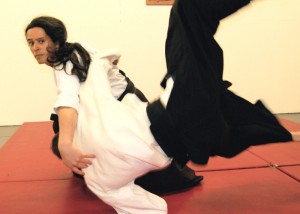 With the ‘harmonising spirit’ mindset of the Aikido student, a stance won’t be to hold on to the ground, or hold the territory they stand upon. Theirs is the art of continuous movement.
With the ‘harmonising spirit’ mindset of the Aikido student, a stance won’t be to hold on to the ground, or hold the territory they stand upon. Theirs is the art of continuous movement.
Although the shapes they put their legs into, when learning a stance, can appear very similar to the shapes the Karate student’s learn, there the similarity ends. Aikido is very much the art of transitions. The student moves through stances, (footwork.) but never holds mentally to one position. In stillness the Aikido student is undone.
Creating instability in the opponent is very much the definition of Aikido. That can only be achieved by constant fluid movment of the Aikido practitioner, harmonising with the opponent’s intentions, so as to undo them. They will have posture, centeredness and balance, all given by the understanding of their stance, but in fact, it’s all based on the art of ‘no stance’, that’s why an Aikido student should never really be able to say they understand Aikido! Aikido stances are not designed to resist or propel force, in fact the Aikido student goes out of their way to avoid force altogether. Instead their stances maintain posture and stability while in motion. The Aikido stance is used as a means of transportation, it gets you towards or away from the opponent, or to put it another way, it moves your centre of gravity in better proximity to that of your opponent’s. This proximity is key to the successful application of all Aikido techniques.
Categories: AikidoBy Tim Dickerson
